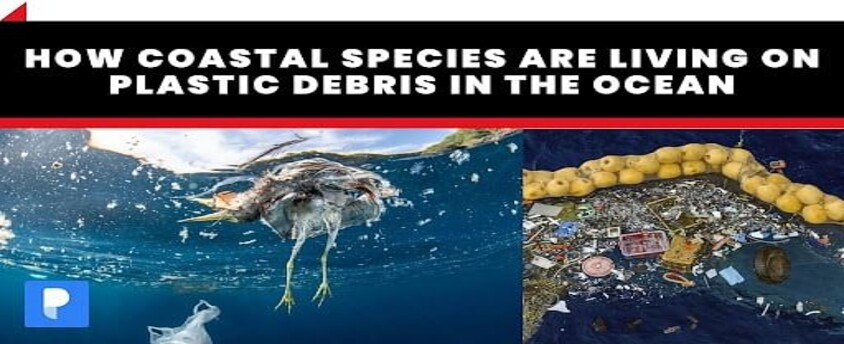How coastal species are living on plastic debris in the ocean
19, Apr 2023

Prelims level : Environment
Mains level : GS-III Environment & Biodiversity |Climatic Change Conservation, Environmental Pollution & Degradation, Eia
Why in News?
- Linsey E. Haram, et al. ‘Extent and reproduction of coastal species on plastic debris in the North Pacific Subtropical Gyre’, Nature Ecology & Evolution, published in April 2023.
Key Details:
- Various scientists have proposed the name “The Anthropocene epoch” for a new period in the history of Earth which has been characterised by the influence of one species (i.e. Homo sapiens) on the planet’s geology and its ecosystems.
- Experts are trying to figure out when actually the Anthropocene epoch really began as some believe that it was when the first nuclear weapon was tested while others feel that it was during the rapid industrialisation phase post the Second World War.
- A few researchers and environmentalists opine that the creation of plastic trash can also be considered the start of the epoch.
- Plastic waste or trash has now become abundant in urban areas, rivers, and also forests.
- Plastic wastes are seen from the slopes of the highest peaks to the depths of abyssal trenches.
- In a recent study conducted by researchers from Canada, the Netherlands, and the U.S., it was found that coastal lifeforms have colonised plastic items in the Great Pacific Garbage Patch.
Great Pacific Garbage Patch:
- The Great Pacific Garbage Patch is a collection of marine debris in the North Pacific Ocean.
- The Great Pacific Garbage Patch is also known as the Pacific trash vortex.
- The garbage patch seen in this region or location consists of two distinct collections of debris inside the North Pacific Subtropical Gyre.
- There are water currents in the ocean that form loops mainly due to winds and the Coriolis force. These are called gyres.
- The North Pacific Subtropical Gyre is a gyre situated immediately to the north of the equator in the Pacific Ocean.
- The gyre consists of the ocean currents such as Kuroshio, North Pacific, California, and North Equatorial currents and moves in a clockwise direction.
- Inside the North Pacific Subtropical Gyre, just north of Hawai’i, lies a long east-west strip of debris that has been collected by the ocean currents over the years.
- As per estimates, the Great Pacific Garbage Patch consists of about 45,000 to 1,29,000 metric tonnes of plastic, mainly in the form of microplastics.
Key findings of a latest study:
- According to researchers, the Japanese tsunami in 2011 contributed significantly to the pile of debris.
- Researchers until 2017 had seen debris washing ashore on the West coast of North America containing live lifeforms that were originally found in Japan.
- Between November 2018 to January 2019, researchers found about 105 pieces of plastic debris from the eastern part of the patch and studies were conducted on this debris.
- Studies revealed that close to 98% of the items found in the debris had invertebrate organisms.
- Researchers also reported that pelagic species (i.e. species of the open ocean) were found on 94.3% of items and coastal species were found on 70.5% of the items.
- Further, the number of coastal species like the arthropods and molluscs seen rafting on such human-made plastic islands of waste was three times more than that of pelagic species.
- Overall organisms belonging to about 46 taxa were found, out of which 37 of them were coastal and the rest were pelagic.
- The coastal species were most seen on fishing nets while the pelagic species were found on crates.
- Among all the species, crustaceans (i.e. animals usually with a hard covering such as crabs, lobsters, shrimps, etc.) were the most common species found.
Relevance of the findings:
- The report notes that the creation of a vast sea of relatively permanent anthropogenic plastic patches since the 1950s has led to the development of a new kind of standing coastal community in the open ocean which has been named the “neopelagic community”.
- According to the researchers, the neopelagic community is not misplaced like the coastal species which were seen on human-made objects in the past, as neopelagic species now thrive on the plastic items in the garbage patch, including reproducing there.
- The researchers have noted that 68% of the coastal taxa and 33% of the pelagic taxa on such garbage patches reproduced asexually.
- Researchers also found that polyethylene films had chemically bonded with rocks in China. This helps us understand the formation of other instances such as:
- The “anthropoquinas” of Brazil where sedimentary rocks were found embedded with plastic earrings.
- The “plastiglomerates” of Hawai’i where beach sediments were found embedded with organic debris, basaltic lava and melted plastic.






